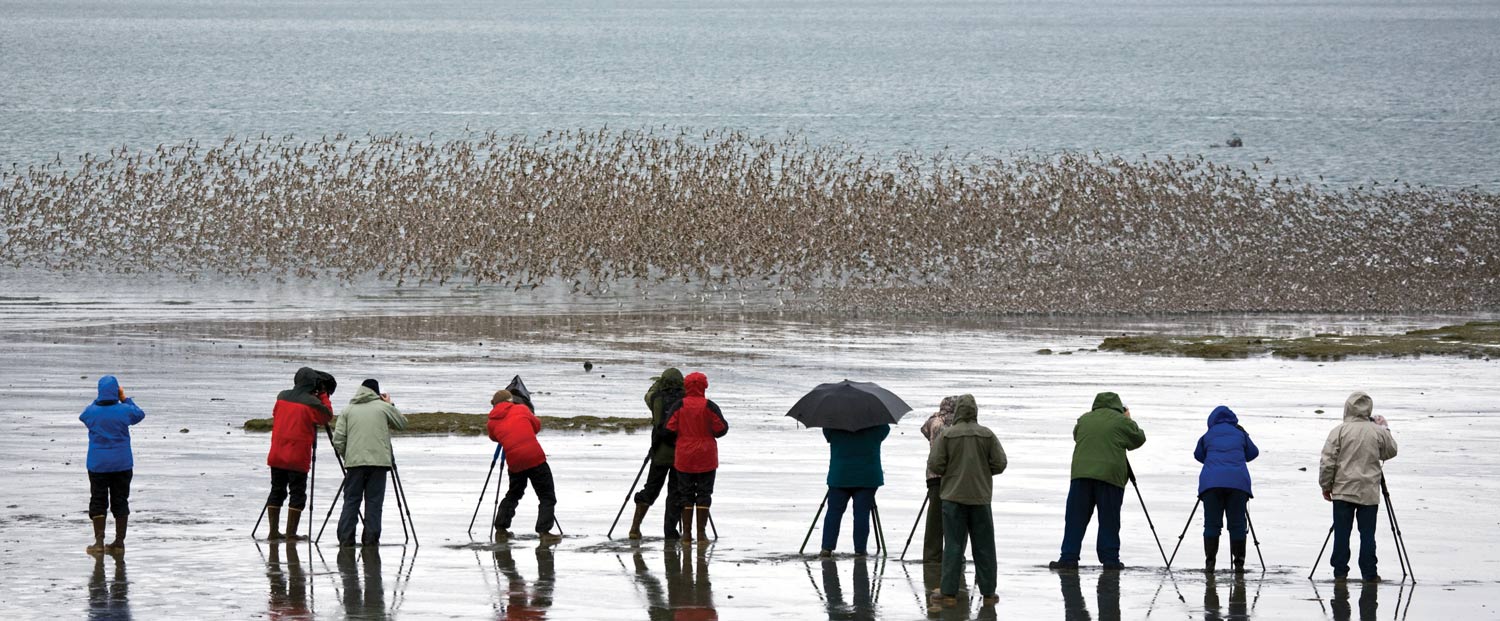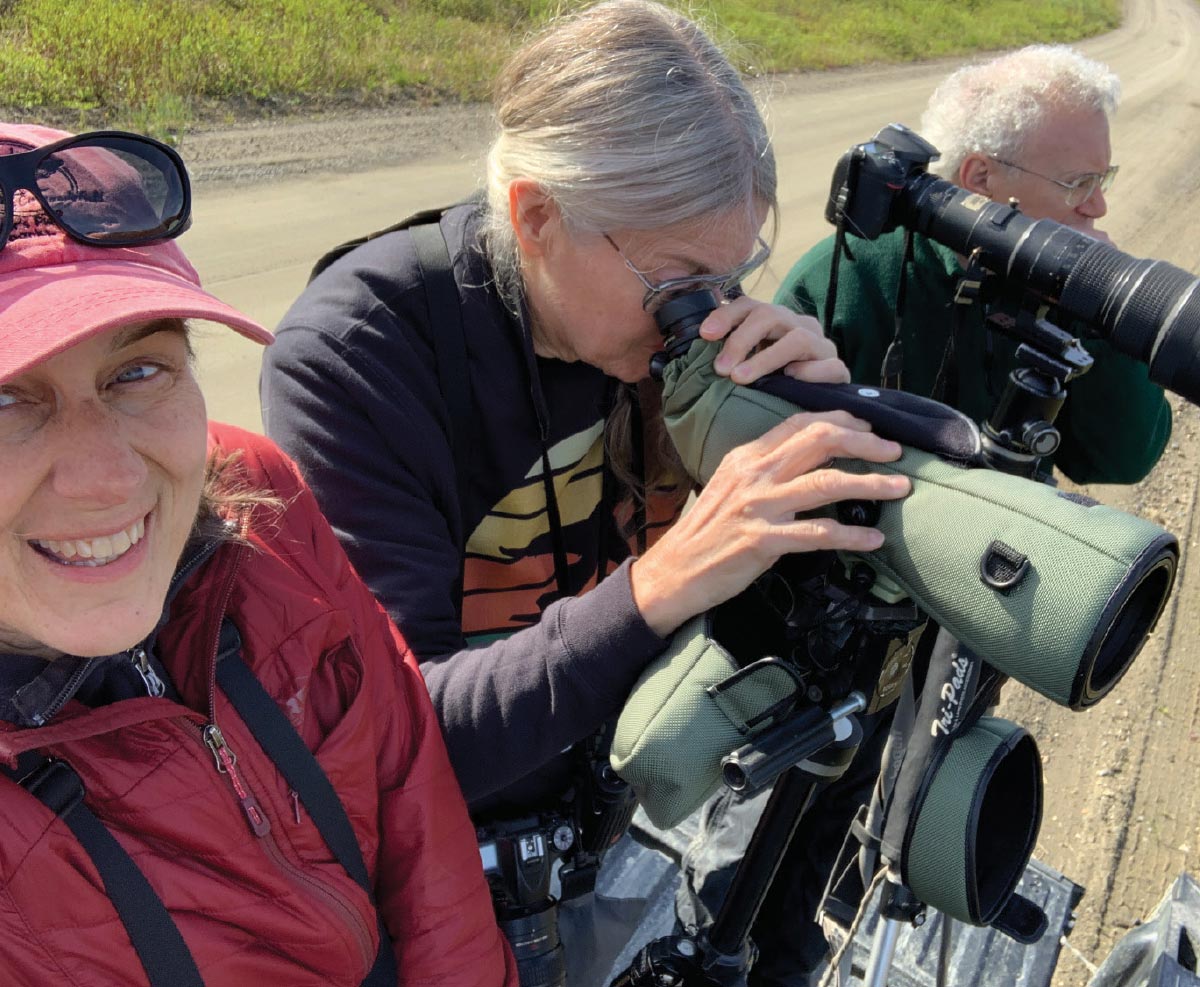ald eagles, snowy owls, Steller’s jays, and willow ptarmigan. Sandhill cranes, red-faced cormorants, emperor geese, and bristle-thighed curlews. The list of birds that live in or migrate to Alaska’s wetlands, coastal areas, and public lands, such as national wildlife refuges and national parks, is long—and so is the distance that birdwatchers from around the world travel to see them.
“Birding is big business in Alaska because of the healthy, resilient public lands and waters of our state,” explains David Krause, Alaska vice president of the National Audubon Society. “These places offer a bunch of different habitat types and, as a result, allow for a rich diversity of bird species.”
In 2022, Audubon Alaska released the study Small Sight—Big Might: Economic Impact of Bird Tourism, which tracked the economic impact of birding tourism. It found that more than 300,000 birdwatchers visited the state in 2016, spending $378 million and supporting 4,000 jobs.
“I suspect that the number has gone up since then, as birdwatching and the enjoyment of birds has increased significantly coming out of the [COVID-19] pandemic,” says Krause, adding that he also believes that bird-based tourism is growing within the state and region.
“The US Fish and Wildlife Service did a survey that showed that, in 2022, 96 million people observed birds around their homes and on trips, and 42.6 million took trips away from home to observe wild birds,” says Krause. “Those are pretty amazing statistics and speak to what Alaska has to offer as a global birding tourist destination.”
Depending on what a birder wants to see, there are birding hotspots across the state. In Haines, for example, visitors can witness the largest congregation of bald eagles in the world, which is estimated to include up to 4,000 individual bald eagles. The northern wheatear, a small flycatcher that winters in Kenya and Tanzania, nests and breeds in Denali National Park and Preserve and other areas of the state. Nome is a birding hotspot, with hundreds of tundra swans in Safety Sound before they migrate out of the region. The Pribilof Islands are known for huge congregations of seabirds, and the Copper River Delta attracts nearly 5 million shorebirds every spring and even holds its own shorebird festival.

“There is an amazing network of conservation system units—including wilderness areas, parks, preserves, and national forests—that help ensure ecosystem health,” says Krause. “As a result, migratory birds come to Alaska from all corners of the globe.”
The Alaska Maritime National Wildlife Refuge, for example, is responsible for protecting coastal habitat for hundreds of thousands of marine mammals as well as 40 million seabirds. Approximately 80 percent of all seabirds in North America breed within the maritime refuge, which extends from Southeast through Southcentral to the end of the Aleutian Islands, across the Bering Sea to the Pribilof Islands, and up the Bering Strait to the Arctic Circle.

Roam Nome

Mike Fernandez | Audubon
Within the refuge, visitors can see numerous North American birds, as well as those that have migrated from Asia, Mexico, Africa, and the Caribbean.
Approximately 40,000 to 50,000 people visit the refuge’s Visitor Center and headquarters in Homer each year to learn about the refuge, its history, and the types of seabirds found in the area. The center, which celebrated its 20th anniversary last year, offers talks, birding excursions, and youth activities for all levels of birders.
While the refuge doesn’t track exact numbers of birding visitors each year, Acting Refuge Manager Jeff Williams estimates that at least 1,000 people come to Alaska Maritime’s coastal areas annually to take part in the hobby, and a large number of opportunistic birdwatchers enjoy the sights as well.
“There are a lot of guides and commercial operators around here that are excellent birders, but we also have fishermen and locals who spend time on refuge islands birdwatching who may be there for a different activity,” says McGill. “There are all sorts of birding opportunities.”
According to Williams, one of the easiest ways to see seabirds on the refuge, as well as sea lions and other marine mammals, is to take a daily cruise out of Seward to the Chiswell Islands. Visitors can also fly to the Pribilof Islands to see tens of thousands of birds, including red-faced cormorants, red-legged kittiwakes, northern fulmars, thick-billed murres, horned and tufted puffins, parakeet and crested auklets, and more during their nesting season.
The refuge is also a leading sponsor partner of the Kachemak Bay Shorebird Festival centered in Homer, which is the largest wildlife festival in Alaska. The event, which spans five days in early May, attracts a substantial number of birdwatchers who generate income for the area through hotel stays, restaurant visits, excursions, and more.
“People shouldn’t be intimidated,” says McGill of the festival that attracts both novices and professionals. “During the shorebird festival, our viewing stations often have expert local birders there with spotting scopes who love to share information. And seeing the mudflats full of shorebirds is an incredible experience, even if you’re not an avid birdwatcher.”
Williams adds that the shorebird festival also has a Junior Birder program in which young people can take part in numerous family-friendly activities, learning more about birds and taking part in discovery labs and games.
Birders also enjoy the Yakutat Tern Festival, Alaska Hummingbird Festival in Ketchikan, Stikine River Birding Festival in Wrangell, Spring Migration Celebration in Fairbanks, and the Utqiaġvik Migratory Bird Festival, among others.
The state also features numerous birding trails, including the Southeast Birding Trail established by Audubon Alaska in 2019.
“The trail isn’t a linear trail; it features a number of accessible sites on a map where people can see different types of birds and ecosystems,” says Krause of the map that features 18 Southeast communities and 200 sites. He adds that there are also birding trails in Anchorage, Fairbanks, Kodiak, and Utqiaġvik.
Carol Gales is the founder of Roam Nome, a guiding business that provides customized birding tours, history/nature tours, day hikes, and snowshoe outings along Nome’s roads. Though she did not grow up birding, Gales took a class about the birds of Alaska while working at UAF’s Northwest Campus in Nome, and she became interested in the hobby. She began driving for birding field trips and, after retiring, decided to start a guiding business with trips for individual birders.

Roam Nome

Lauren Cusimano
“Our area includes a wide variety of shorebirds and songbirds that migrate to the area, as well as year-round residents like the willow ptarmigan and rock ptarmigan,” says Gales. “And because we have so many waterfowl here, visitors can actually see all five species of loons just off our road system.”
Northern Alaska is the crossroads of five global migratory flyways. The West Pacific and East Asian-Australasian flyways bring birds from as far away as New Zealand, and three of North America’s four flyways— the Mississippi, Central, and Pacific—converge in the Arctic.
“The bristle-thighed curlew only nests in a very few specific places, including here and in the Yukon-Kuskokwim Delta,” Gales observes. “There is a place on the road system at Mile 72 where you can hike up a hill to search for them.”
While some birders choose larger group tours, Gales says a more personalized tour has advantages.
“In a bigger group tour, people have different goals,” she says. “Some people want to have a big list, so they want to see as many birds as possible. Others may not have birded at all and want to spend a lot of time on a fairly common sparrow. Still others want to take photos and may spend a really long time trying to get a close-up shot of a bird.” Smaller tours can cater to these individual needs.
Gales’ tours range from about eight to twelve hours, and she offers three-day tours with each day covering a major road. “Guests bring lunches, and we go all day, mostly on the road system because we can see more birds per hour,” she says, noting that while hiking is a good way to see birds, it is not as efficient as a driving tour.
“I bring out a spotting scope so we can watch birds feeding their young, displaying to mark territory, hunting, and more,” says Gales. “Most of my guests also appreciate the landscape, the remoteness and wildness of it all. And I throw in a bit of history and information about living in Nome, if they’re interested in that.”
While Gales offers year-round tours, the most popular time for birdwatching in the Nome area is at the end of May and during the first two weeks of June. Winter brings those who want to see the McKay’s bunting, a rare North American breed that nests on a remote island in the Bering Sea but comes to the mainland in winter.
“We had a guest who was doing his ‘Big Year,’ which is when individual birders set a goal for themselves to see a certain number or type of birds in a certain area—a county, state, or whatever,” says Gales. “He flew in to see a McKay’s bunting on our bird feeder, then went to the airport the same day and left.”
While that was the fastest turnaround Gales has seen, most birders visiting Alaska stay longer, enjoying both the birding experience and the state itself.
“What’s neat is that all of these people are very interested in ecology and conservation and, no matter their political stripe, are concerned about the environment and how climate change can affect the bird population,” Gales says. “They don’t take anything more than pictures.”
But birdwatching tourists leave behind more than footprints. “While they’re here, they stay in hotels and buy food and support the local economy; there’s nothing negative about the hobby,” Gales notes. “I’d love to see Alaska promote it more.”